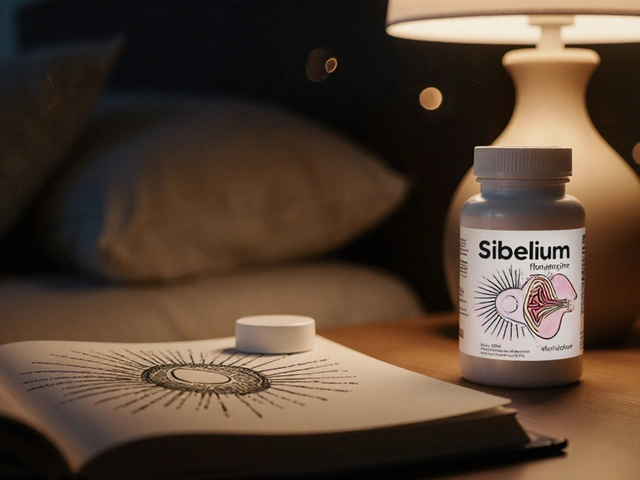If you ask anyone in their late forties or fifties about the menopause rollercoaster, you’ll probably get an earful about hot flashes, sleepless nights, and mood swings that make teenagers look mellow. With all this, hormone replacement therapy (HRT) pops up as both a savior and a source of debate. One name stands above the rest: Premarin. Some call it a lifeline. Others, a risk not worth taking. Yet, it’s on millions of prescriptions in dozens of countries, promising relief when everything else fails. Here’s where things get interesting: Premarin is made from an unlikely source and has a history full of both breakthroughs and controversy. Let’s break it all down and see why Premarin still draws attention, questions, and strong feelings.
What Exactly Is Premarin, and Why Is It So Popular?
So, what is this famous little pill? Premarin is a type of hormone replacement that’s been around since 1942—yep, it’s older than rock & roll. The name itself is a shorthand: PREgnant MARes’ urINe. That’s right. The main ingredient comes from pregnant horses’ urine, processed in huge farms where mares live just to help produce this estrogen-rich liquid. It sounds strange, even a bit off-putting, but that blend of natural estrogens turns out to be powerful. Doctors prescribe it mostly for women struggling with menopause symptoms—night sweats, hot flashes, and those dry spells that make intimacy, well, less fun. It can also help prevent thinning bones (osteoporosis) after menopause, which is a constant worry as estrogen levels drop.
Why is Premarin still so common when newer synthetic options exist? Its blend of estrogens—mainly estrone, equilin, and a bunch of others—does something that a straightforward synthetic estrogen can’t. Studies in the 1990s and early 2000s compared Premarin to just estradiol (a common man-made estrogen) and found that some women simply responded better. They felt better, slept deeper, had fewer mood swings, and even had better results for bone strength. While not a miracle drug, Premarin worked so well that American doctors wrote over ten million prescriptions a year at its peak in the late 1990s.
But it’s not just tradition. The drug’s widespread use also comes from simple practicality—insurance covers it, doctors know it, and there’s a long safety track record (warts and all). Walk into most pharmacies, and they’ll have those little round beige tablets waiting. If you’re wondering why you don’t often hear about any competition, here’s the short answer: when something works for decades and insurance companies are happy to pay, most folks just stick with what’s tried and tested. The bottom line: Premarin became the go-to for a reason, and for many women, it’s still the safest, most familiar choice on the market.
How Does Premarin Work? What Can You Expect?
Let’s get real about what happens after you swallow that first tablet. Your body gets a fresh hit of estrogen—the stuff your ovaries used to pump out before menopause slowed them down to a trickle. Suddenly, those racing night sweats and red-hot flashes? They start to cool down. Vaginal dryness that makes every visit to the bathroom a mini-nightmare? That fades, too. Mood swings, anxiety, and sleep issues might also back off, giving you one less thing to worry about. Over a few weeks, most women say they not only feel better but actually enjoy life again. A big deal, because menopause can make even the simplest things feel overwhelming.
Now, not every woman has the same story. Some need only a low dose to notice huge changes, while others chase just the right dosage for weeks. It’s not about instant fixes. The body needs time to adjust, since you’re basically rebooting a key hormone system. The pill works by mimicking the action of natural estrogen in nearly every tissue in the body: bones get stronger, cholesterol levels swing in a better direction (LDL goes down, HDL goes up), and even blood vessels relax more easily. This is why doctors sometimes recommend HRT, including Premarin, to help keep bones solid and reduce the risk of osteoporosis—a major downside of menopause often overlooked until someone gets a surprise fracture.
It’s not a universal win, though. Some report headaches, breast tenderness, or mild nausea within the first month. Digestive changes, body aches, even irregular bleeding can crop up, but usually fade as the body gets used to the new hormone levels. The key here is patience and honest feedback with your doctor. If side effects get too annoying, the right move is to tweak the dose until it feels nearly invisible.
| Common Benefit | % Reporting Improvement |
|---|---|
| Hot Flash Relief | 85% |
| Vaginal Dryness | 70% |
| Better Sleep | 63% |
| Improved Mood | 57% |
| Increased Energy | 54% |
| Fewer Night Sweats | 80% |
The biggest tip if you’re starting Premarin: keep a journal. Document your symptoms, dose, and any reactions. Bring it to appointments so your healthcare provider can see exactly how you’re doing. And don’t skip doses—hormones like schedule and routine. Keep up with annual checkups (including blood pressure, breast exams, and pelvic checks), as added estrogen can bump up risks for certain health issues. If you smoke, be extra careful: the risk for blood clots shoots up when you mix smoking and estrogen therapy.

Risks, Controversy, and Misconceptions: What Every Woman Needs To Know
This is where things get real complicated, real fast. In 2002, the Women’s Health Initiative Study flipped HRT—especially Premarin—on its head. The headlines screamed: "Hormone therapy causes breast cancer and heart attacks!" Suddenly, women everywhere stopped their pills, worried sick they’d already done damage. The truth, as usual, was messier. The risk numbers were real, but not as dramatic as news stories made them sound. Heavy, long-term use (more than five years straight) did nudge up the chance of blood clots, stroke, and certain cancers, especially for those over 60 or who started therapy late into menopause.
But, here’s the nuance most people missed: For women who started HRT right around their very first menopause symptoms, the risk was much lower. In younger women (aged 50–59), the risk of heart problems barely budged—sometimes it even dipped. Breast cancer risk jumped only with added progestin (the other part of HRT for those with a uterus, used to stop the uterus lining from getting too thick). Using just estrogen, as with Premarin, the numbers were much less scary. Still, the stigma from those headlines sticks around to this day, making some women fear Premarin without knowing if the risk even fits their situation.
Let’s talk honestly about side effects and dangers. Besides the occasional headache or stomach upset, big-picture concerns circle around blood clots, stroke, and certain cancers. How likely are these? For every 10,000 women aged 50–59 on Premarin for less than 5 years, about 3 more may get blood clots and about 6 more may have a stroke, compared to non-users, according to follow-ups from the same study. Not zero, but not nightmare odds either. Other misconceptions often come up—like the idea that natural plant-based estrogens (phytoestrogens) in soy or flaxseed are just as strong or safer. In truth, they can help a little, but their effects pale in comparison to pharmaceutical estrogens like Premarin.
Premarin also faces ethical scrutiny. Animal rights activists have called out the conditions for the mares used to make it, and there are now synthetic conjugated estrogens available that don’t depend on animal sources. If that’s something you care about, talk to your doctor—options like Cenestin and Enjuvia are alternatives. Otherwise, the decision comes down to symptom severity, personal risk tolerance, family history, and age. No single answer fits everyone. If you’re worried, don’t settle for headlines or rumors—get your risks calculated, and talk to a doctor who really knows how to balance those tricky menopause choices.
Tips, Real-Life Stories, and Taking Charge: How to Make Premarin Work For You
One of the most useful truths about HRT—especially a longtime staple like Premarin—is that it’s not "one size fits all." Real stories from users read like a map of modern menopause: Jane in Ohio says it took two tries to find her right dose, but after three years, she has her old self back. In contrast, Lila in Toronto gave up after six months, frustrated by breast soreness that didn’t fade. Both are valid outcomes. The trick is customizing everything for your own needs. Start at the lowest dose that helps. Track every symptom—don’t downplay what bugs you or what gets better. Share that info openly at every checkup. If you have a uterus, make sure you’re getting the added progestin, which protects against uterine issues. Some women combine Premarin with a skin patch or vaginal cream, especially if dryness stays a problem or the pill upsets their digestion.
- Keep every follow-up appointment: That’s your time to ask blunt questions and push for the answers you need.
- Discuss every family history detail: Cancer history, clots, stroke, or heart attacks? Your doctor needs to know every bit.
- Never skip your yearly mammograms and Pap smears if you’re on hormone therapy—catch anything early, just in case.
- If you’re worried about bone loss, ask for a bone mineral density scan (DEXA scan). Estrogen helps, but only if you’re also getting enough calcium and vitamin D.
- Solid exercise habits matter: Walking, weight-bearing workouts, or yoga boost bone health and can ease menopause “brain fog.”
- Watch lifestyle habits: Smoking and heavy drinking raise risks—not just for HRT users but for everyone as they age.
Talk openly with your partner or loved ones. Menopause isn’t something women should face in silence or embarrassment. Some couples say that HRT, including Premarin, let them keep intimacy and connection strong when it started slipping away. Skeptical? Ask around. Modern menopause forums are full of women comparing notes, trading tips, and sharing what really worked. Even so, don’t fall for miracle promises or over-the-counter “natural” blends that haven’t been properly tested—the real science still says estrogen is the only thing proven to truly provide big relief for most menopause symptoms.
If the ethical debate over animal sources keeps you up at night, don’t feel powerless. Look for synthetic versions, or even non-hormonal options that can help with certain symptoms. But for many who have tried it all and just want their life back, Premarin is still the prescription that delivers. Listen to your own body’s signals, stay informed, and demand someone who’ll treat you as a partner in your own care—not just a number.







Greg DiMedio
July 17, 2025 AT 23:27Well, isn't Premarin just the classic case study of hormone therapy drama? I mean, yeah, it helps with the hot flashes and all, but have you seen the laundry list of side effects? It's like, take the pill and suddenly your body's throwing a party you never RSVP'd to.
Also let me just say, the fact that it’s made from pregnant mares’ urine sounds like something out of a weird science experiment rather than actual medicine. No wonder there’s so much controversy. And seriously, can someone explain why we’re still prescribing it when there are synthetic options that supposedly have fewer risks?
Either way, before diving headlong into this, make sure you’re not just buying into the hype of the “gold standard” because sometimes gold is just flashy but brittle.
Sonia Michelle
July 20, 2025 AT 07:17I totally agree that it’s important to look beyond the surface and weigh real benefits against risks carefully. What stood out to me in this post is how personalized hormone therapy really needs to be.
Menopause affects each woman differently, and Premarin might be a lifesaver for some, restoring balance and comfort, but others may face tough side effects. That’s why consulting a healthcare professional who really listens and understands your unique body chemistry and health history is so crucial.
Also, the myths around hormone therapy are rampant —dispelling those myths with clear, honest information empowers women to make their own informed choices without fear or confusion.
Badal Patel
July 21, 2025 AT 07:17Oh, dear God, here we go again!!! The so-called "best-known" estrogen therapy? Really!!! How can anyone still peddle Premarin in the 21st century when so many controversial facts and objections have been raised for decades - from its animal-derived origins to the questionable long-term safety profile?!? It is nothing short of a travesty that this "therapy" persists without more rigorous scrutiny!!!
And let us not overlook the dramatic side-effects that can arise! Premarin should not be embraced blindly, but rather critically evaluated, discussed extensively with evidence-backed caution, and reserved for cases where no better synthetic alternatives exist!!!
Kara Guilbert
July 22, 2025 AT 12:53Frankly speaking, I believe we have to be morally conscious when discussing medications like Premarin. The ethical concerns surrounding the use of pregnant mares’ urine can't be overlooked any longer.
While hormone replacement therapy can genuinely improve quality of life, supporting women's health through menopause, it’s imperative to also consider animal welfare. There are alternatives developed with less cruelty that deserve our attention and preference.
We owe it to both women and animals to seek compassionate, ethical solutions moving forward.
Neil Collette
July 24, 2025 AT 21:27Oh great, another cheerleading post for Premarin. Let me guess, it “gets personal” but conveniently ignores the mountain of studies showing increased risks for blood clots and cardiovascular issues? How about the inconvenient truth that Premarin is literally antiquated pharmaceutical from the last century masquerading as safety?
Honestly, it’s refreshing to see some honesty but this post seems light on hard-hitting risk talk and heavy on feel-good anecdotes. More critical analysis is warranted instead of gentle myth-busting.
But hey, if you want your estrogen cocktail with a side of drama, who am I to judge?
joshua Dangerfield
July 26, 2025 AT 03:20For anyone on the fence, I'd recommend really having a heart-to-heart with your healthcare provider, maybe even a second opinion. Hormone therapy isn't one-size-fits-all, and Premarin, while effective, carries nuances that deserve careful consideration.
What I appreciate about this piece is the focus on busting myths — it really empowers me as a reader to understand this complex topic better. Knowledge is power, after all.
Does anyone here have personal experiences with Premarin they want to share? Real stories can help us all get a clearer picture.
Kasey Lauren
July 28, 2025 AT 09:27It's encouraging to see this guide present both benefits and risks. Menopause can be such a tough transition, and having hormone therapy options like Premarin can genuinely make a difference in quality of life.
I like that the post doesn’t shy away from the realities, including side effects and controversies, because we need open conversations about these medical decisions.
Just wish more doctors were as transparent and supportive in real life!
KIRAN nadarla
July 29, 2025 AT 13:33From a purely analytical perspective, the focus on Premarin’s biochemical properties is crucial. However, the post could be more precise with terminology and clearer references to clinical studies.
For instance, while discussing risks, exact percentages and study names would offer more credibility, instead of vague phrases like "controversies" or "side effects." Precision in language reflects precision in medicine.
Furthermore, greater emphasis on alternatives and comparison of efficacy and safety profiles would sharpen the value of this guide.
Abhimanyu Singh Rathore
July 31, 2025 AT 19:13Hey everyone! Just wanted to add some punctuation here!!! Honestly!!! Over-punctuation can be distracting, but when discussing serious topics like Premarin, clarity and emphasis are vital!!!
That being said, I think it's important to also highlight that every medicine has its place — and while Premarin does have its share of critics, it has helped countless women manage symptoms that severely impact quality of life!!!
Always consult your doctor, get all your questions answered, and never underestimate the power of being informed!!!
Dennis Scholing
August 3, 2025 AT 01:57Greetings everyone! This article represents a well-rounded introductory resource concerning Premarin and hormone therapy options for menopause relief.
One particularly supportive aspect of the guide is its emphasis on personalized care and informed decision-making, which aligns with contemporary best practices in medicine.
I would encourage all readers to discuss comprehensively with their healthcare providers, evaluating individual health circumstances and preferences before initiating any hormone treatment.
Additionally, continued research and sharing of experiences contribute greatly to collective understanding and safety enhancement in this area.
James Lee
August 15, 2025 AT 19:40Ah yes, Premarin. The star of the 'let's age gracefully but cautiously' show. This article tries to sound like an all-encompassing guide but reeks of that pseudo-intellectual charm some think is enough to solve decades of medical ambivalence.
What's truly fascinating is the symbolic nature of Premarin—urine-derived estrogen, an odd concoction passed down through the annals of pharmaceutical tradition. It’s almost poetic, really.
But for all its history and purported benefits, the question remains: how much of this is genuinely progress and how much is just glorified placebo with a side of well-packaged risk?